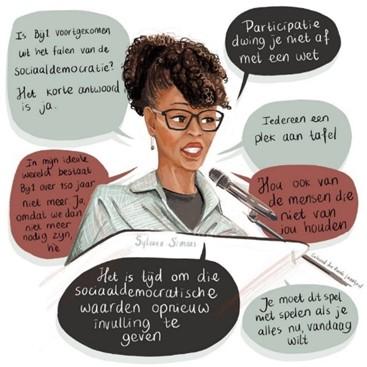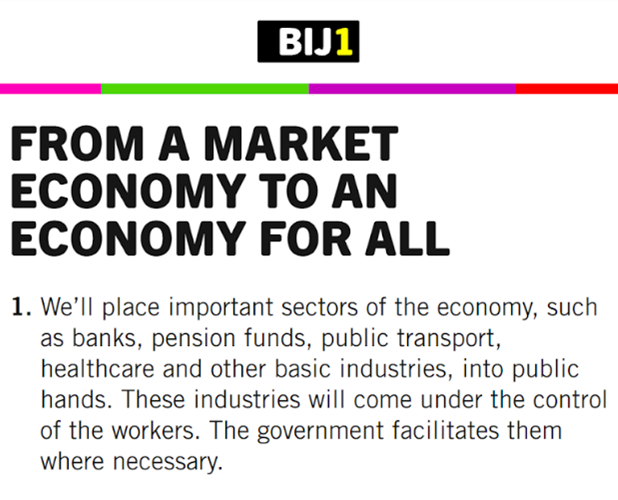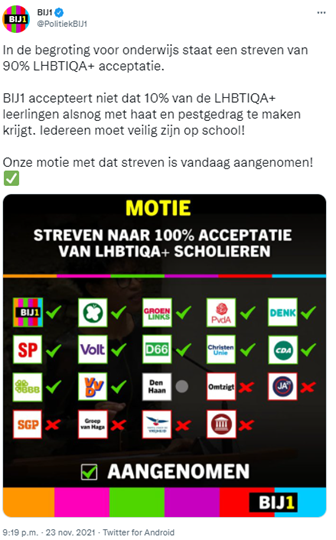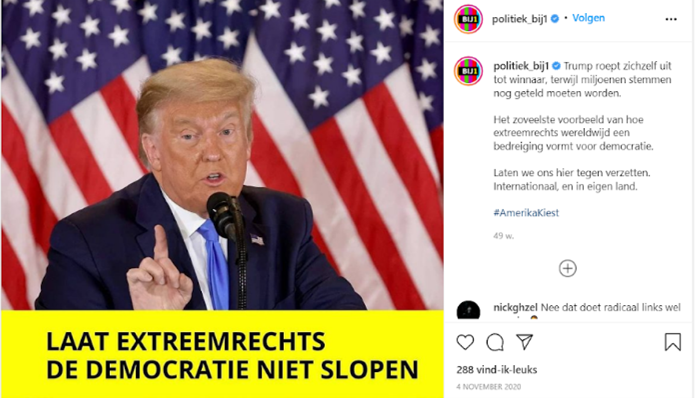
How Sylvana Simons Attempted To Reinvent Social Democracy
Sylvana Simons was the founder of BIJ1 an antiracist and egalitarian political party in The Netherlands. Now that Simons has resigned as party leader, it is worthwhile to zoom in on her legacy. Simons -a modern and anti-racist advocate of social democracy - succeeded, through the clever use of the algorithmic logic in the hybrid media system, to generate quite some uptake with her small party.
Sylvana Simons knows where she comes from
A ‘historical moment’, as Parool called it: Sylvana Simons became the first black woman in the Dutch parliament when her party Bij1 obtained one seat in the 2021 elections. It is only since 2016 that Bij1 has opened fire on the current situation in the Netherlands. Whilst truly valuing digital media and achieving a feeling of unity among the public, they have shown themselves ready to fight for what they believe in - equality, radical equality. But what lies at the core of this activistic party? The will to change the capitalist hegemony. And that, we have seen before.
During the glory days of radical Enlightenment in the late eighteenth century, the radical philosophers saw equality as the universal dimension of freedom (Maly, 2012). Inequality meant suppression, and therefore a lack of freedom. That lack of equality was felt during the then existing 'ancient régime'. In the eyes of radical Enlightenment thinkers, everyone should obtain rights simply due to the fact they were people. Neither social classes nor economic status should matter. These ideas were a ‘Revolution of the mind’, as Israel (2009) calls it, with egalitarian and democratic core values. Eventually, the concept of ‘radical equality’ rose too. This included representative democracy, racial and sexual equality, full freedom of thought, expression and the press (Israel, 2009). Equality as a condition before the law was, at least for some radical Enlightenment thinkers, not deemed enough. The concept inspired some, like Mirabeau, to strive for more and stress the importance of some kind of socioeconomic equality. They argued for at least some redistribution of wealth in other to achieve a good society .
Throughout the 19th century new ideologies resulted out of radical Enlightenment. The most famous and influential political ideology of that and the subsequent century was without a doubt socialism. In the 19th century, the industrialization brought capitalism to a new phase. The factory owners, or capitalists, increasingly exploited the working class, or ‘proletariat’ as Karl Marx and Friedrich Engels called it (Blommaert, 2011). The only objective for the capitalist was to make as much money as possible, without taking any interests of the proletariat into account. That is why Marx and Engels advocated for more equality and freedom for the proletariat, which eventually evolved into socialism (Blommaert, 2011). So again, the current system of class inequality was attacked. Fighting for equality now meant fighting capitalism.
One of the movements in the socialistic way of thinking was that of the social democrats. Like revolutionary socialism, they were against capitalism. Capitalism is viewed as a system that wants to lower their costs - labor cost in particular - in order to maximize the profit (Blommaert, 2011). Different from the socialists, social democrats believed that liberal democracy could be used to reform the capitalist system (Fielding, 2003). The capitalist system ought to be more regulated in order to work more efficiently and meet the interests of the majority. ‘State ownership’, laying the power of certain fields in the hands of the government, was supposed to help move towards those interests. As a result, the concept of classes should become one of the past (Clarke, 1983).
History repeats itself
Interesting is that Bij1 positions itself in this socialist tradition, but outside of the existing socialist and social democratic parties in the Netherlands. The young party combines the concept of equality of the radical Enlightenment with the more anti-capitalist rhetoric of the heydays of social democracy. They take up the idea that radical Enlightenment thinkers also advocated for which is that everyone has or should
‘have the same basic needs, rights, and status irrespective of what they believe or what religious, economic, or ethnic group they belong to, and that consequently all ought to be treated alike, on the basis of equity, whether black or white, male or female, religious or nonreligious, and that all deserve to have their personal interests and aspirations equally respected by law and government’ (Israel, 2009
Moreover, Simons states: ‘It is time to redefine social democratic values’. But how does Bij1 intend to achieve this?

Sylvana Simons on 150 years of Social Democracy
Following the social democratic thoughts, there is a huge focus on equality. Through equality, the public can experience the freedom to be who they are and want to be. The concept of ‘radical equality’ is even literally mentioned in the website header of Bij1. One of the ways Bij1 wants to create this equality, is through state ownership. Bij1 wants the government to control banks, pension funds, public transport, healthcare and other basic industries. Once the state owns these sectors, there will be no interference by the free market. This way, it can be ensured that no profit is generated by the basic industries needed for living and organizing society.

Header of the Bij1 Website
As we come to understand, Bij1 aims to cater to the needs of the entire population. Their party program contains the quote ‘DOWN WITH THE DICTATORSHIP OF THE FREE MARKET’. Furthermore, they state that ‘capitalism is a system that wants to produce as much as possible at as little cost as possible’. One can recognize anti-capitalist ideas here. Due to the free market, inequality is a close threat. That is why Bij1 wants to create a more diverse ‘welfare state’. In such a state, the basic industries above are easily accessible or free and provided by the state (Blommaert, 2011). Even though the Netherlands already established a welfare state in the 1950's , scholars argue that there has been a decline of it in the past decades (Koops, 2023; Yerkes & Hummel, 2020). According to Bij1, capitalism is (one of) the reasons for that decline. In other words, the anti-capitalist and diverse welfare state-view of Bij1 is another way of battling for equality for all as a universal dimension of freedom.

Part of the Economy Programme
Tweeting history
In times of radical Enlightenment, printed media like newspapers and pamphlets were new media. Nowadays, digital media takes on that role. Digital media allows us to have mediated online interaction (Thompson, 2020). There is an asynchronous, computer-mediated dialogue. Rather than one-to-one, mediated communication is now many-to-many. Together, both traditional and digital media types make a hybrid media system. Therein, various forms of media have evolved into a system through mutual interactions between newer and older media. Rather than seeing the media as separate units, one should look at it as a whole. Bij1 started as a party in that unity, and it shows. Parties, even self-proclaimed radical parties, have to position themselves in this new and ever changing media system. Whereas older parties had to adapt to the development of the hybrid media system, Bij1 made a fresh start in it. That way, they were able to more easily adapt to the ‘algorithmically-powered attention-based hybrid media system’ we are living in.
The 'algorithmic power' lies in the (co-)determination of which information we consume, and how we do so. This power is very much diffused through the entire hybrid media system. Fully digital media like Instagram use algorithms, but nowadays newspapers have websites, YouTube and Instagram accounts too. Through interaction, the subject becomes visible for an algorithm. When the subject is visible, it is enabled to gain popularity. That popularity can occur in the form of uptake. Uptake is ‘a kind of perception or awareness that can lead to the recycling or reinterpretation of a fragment’. That means there are no longer just consumers online: most of us are also prosumers. People are able to actively contribute to discourse. And because of the fact that visibility is algorithmically organized, uptake is key in this process.
This way, Bij1 can be a prominent actor in the public debate, despite having only one seat in the parliament.
So, how is it that Bij1 creates this interaction and uptake? By focusing on emblematic cases full of emotion, and taking these cases with them through the entire hybrid media system. The emblematic cases evoke strong opinions of both agreement and disagreement. This way, Bij1 can be a prominent actor in the public debate, despite having only one seat in the parliament. I will discuss three of those emblematic cases, and how they all rely on other elements of the hybrid media system: the LGBTQIA+ community, the Black Lives Matter (BLM)-movement, and the presidency of Donald Trump.
Bij1 shows they support the LGBTQIA+-community in various ways. As can be seen below, Simons painted her nails in the colors of the pride flag. This can be seen as banal or not relevant by a superficial observer. However in their case, this seemingly non-political act is emblematic for the party's political agenda for radical equality. By selectively taking up certain issues, such posts allow Bij1 to create a social democratic 'brand' (Lempert & Silverstein, 2016). This surpasses the textual content. Not only is Bij1 standing up against inequality, they also show it visually. In their color usage, the diversity and in this example the nail polish. Of course, the party does more than posting political beauty pics. Bij1 regularly organizes protests to address and fight against inequality. The picture of the nails thus aligns with the other posts, actions and the overall discourse of the party.

Simons painted her nails in the colors of the LGBTQIA+-flag
Furthermore, Bij1 is responsive when it comes to news in this category. On 7 September 2021, NRC published an article about a high school that suppressed students who identify as part of the LGBTQIA+-community. Later that month, Bij1 was very vocal in the debate concerning this subject , as they initiated a motion to strive for full acceptance of LGBTQIA+-students. Simons' plea seems to have been effective; the motion was passed. Bij1 then posted about this result on Twitter. Again, this 'on-message' post illustrates their fight for radical equality and provides a great example for the contemporary view of social democracy Bij1 promotes (Lempert & Silverstein, 2016).

Proposal for 100 percent TGBTQIA+ Acceptance in Schools
The case of the Black Lives Matter-movement is similar. The Dutch saying ‘doe maar normaal, dan doe je al gek genoeg’ (i.e. just act normal, that is crazy enough) doesn’t seem to apply to the way Bij1 promotes their message. They organize rallies, calling for solidarity by going to the protest. This choreography of assembly combines face-to-face rallies with digital media. Multiple usage of words like 'radical', using bright colors and focusing on emblematic cases of inequality creates a sense of urgency and makes their messages stand out visually. This is easily aligned with their activist identity. The fight against the current hegemony unfolds itself both in the streets and online. Bij1 keeps on posting messages on this subject, before taking part in the face-to-face rally. This results in some great uptake as well. People join the rally and tweet about being there. Simultaneously, there is a livestream on Youtube. RTV-Utrecht is also there to report, broadcasting live on television. Later, an article is published in a newspaper. Here we see the system at full effect, with all media having its own place in the flow of events. An extra dimension is the fact that Simons has had negative experiences concerning this subject. As she said in an interview: ‘after 45 years of being a black woman, I was fed up with it. […] I am done with the structural inequality we have been accepting’. .In the person of Simons, we see an updated social democratic ideology that not only points at capitalist structures as the cause of inequality, but also foreground discrimination on the basis of race, gender, and sexual orientation.
American political parties and movements promote their ideologies in quite an extravagant manner. Think about the rallies Trump had, the BLM-Protest and what happens in the United States on social media through Trump or about BLM. Such a strategy is comparable to the vibrant color usage and no-compromises attitude of Bij1. The content of Trumpian politics is not at all comparable with Bij1, quite the contrary actually. The election of Trump is used in the Dutch context to warn the public . A warning for the power of the right-wing, with a leader that tolerates inequality and stimulates the free market. Here, we see Trump’s point of view being re-textualized and made functional in the Dutch context They use Trump as emblematic for the political situation in the Netherlands, and present themselves as the alternative. Here, it is clear to see how past parts of discourse are recycled to form new discourse from another point of view.

Intertextuality of the Presidency of Trump
Algorithmic knowledge
This algorithmic knowledge and focus on uptake is of great use. However, there is more to it. Bij1 uses the affordances of the media they are active on. On Instagramthey cleverly appropriate specific hashtags. Bij1 for instance regularly tags Simons in their posts and Instagram Stories. Appropriate interface usage is complementary as well. Again taking Instagram as an example, the covers of their Instagram Stories are styled like the rest of their messages. The vibrant colors immediately draw attention.
Finally, network effects should be taken into account. An active audience can reinforce or create uptake in for instance traditional media, especially when the activity leads to a message becoming viral. A famous tv-personality commenting on a Bij1 post will lead to more visibility via his network. On top of that, Bij1 will be associated with the celebrity. This of course helps in further constructing their brand.

Famous tv-personality responds to a post of Bij1
Based on the frequency of hashtag use, Bij1 has an advantage on other small parties in the Dutch parliament. Both Bij1 (#bij1, 3700 messages) and Simons (#sylvanasimons, 1200 messages) are used more than those of Ja21 (#ja21, 3400 messages) and Joost Eerdmans (236 messages).
As we have seen, the emblematic cases simply form the part of the inequality issue that generates the most uptake. Bij1 sees that uptake as the best way to keep on fighting for radical equality. By generating enough interaction-stimulating input, Bij1 produces plenty of uptake throughout the entire hybrid media system. The balance between input and uptake results in valuable discourse. In that discourse, they seem to update social democratic ideology with anti-capitalist, anti-racist and anti-discrimination thoughts. With this message, Bij1 wants to showcase prominently that they are all in the fight for groups who are now marginalized and excluded. Persevering with this strategy, Bij1 continues to fight for a new social democratic system.
References
Blommaert, J. (2011). Socialisme voor (her) beginners. uitgeverij EPO vzw.
Callaghan, J., Fielding, S., & Ludlam, S. (Eds.). (2003). Interpreting the labour party: approaches to labour politics and history (Critical Labour Movement Studies Series). Manchester: Manchester Univ. Press.
Clarke, P. (1983) ‘The social democratic theory of the class struggle’, in Winter, J. (ed.) The Working Class in Modern British History, Cambridge
Yerkes, M., & Hummel, B. De Nederlandse verzorgingsstaat is doorgeschoten in zijn verwachtingen dat burgers én zelfredzaam én digitaal vaardig zijn. (n.d.). https://www.volkskrant.nl/columns-opinie/de-nederlandse-verzorgingsstaat-is-doorgeschoten-in-zijn-verwachtingen-dat-burgers-en-zelfredzaam-en-digitaal-vaardig-zijn~b2697b92/
Israel, J. (2009). A Revolution of the Mind. Princeton University Press.
Koops, E. (2023). Verzorgingsstaat – betekenis, kenmerken en korte geschiedenis. Historiek. https://historiek.net/verzorgingsstaat-betekenis-geschiedenis/128717/
Lempert, M., & Silverstein, M. (2012). Creatures of politics: Media, message, and the American presidency. Indiana University Press.
Thompson, J. B. (2020). Mediated Interaction in the Digital Age. Theory, Culture & Society, 37(1), 3–28.